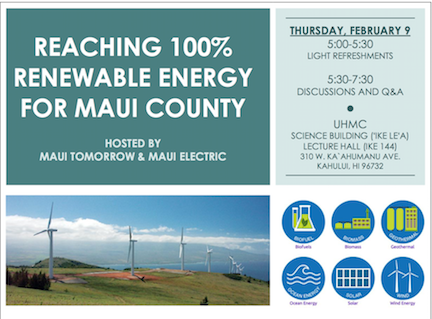As part of Maui Tomorrow’s mission to facilitate discussion and air all sides of the debate over Big Wind and the Interisland power cable, today we reprint a Viewpoint from Friends of Lana’i, a group opposed to the Big Wind project. This does not necessarily reflect the views of Maui Tomorrow which has taken no position on the project as of this writing.
Interisland Cable Still A Bad Idea
Here we go again. Senate Bill 367, last session’s failed attempt to facilitate financing and construction for an interisland undersea cable, ended the year deferred in Conference Committee. Its proposed replacement, SB2785, remains a seriously flawed legislative effort to establish those same regulations and financing arrangements.
SB2785 is premature, opaque, would prove obscenely expensive for Hawaii’s ratepayers and all taxpayers, while turning an indifferent eye to the fundamental foundation of Hawaiian culture: the social and environmental impact on its communities. It is simply the wrong answer to the right question.
Hawaii must attain energy independence; that part of the proposed legislation is correct. But how does an undersea electric transmission cable linking us all together provide “…increased energy security”? Would it not in fact make us more vulnerable? Either by accident or design, any break or disruption to an interisland undersea cable would clearly endanger the energy security of us all.
This bill positions the proposed undersea cable as providing every island “with backup power.” How will it do that, when none of the power produced by the intermittent wind plants proposed on Lanai and Molokai stays on those islands? Are we seriously considering taking over and irreparably destroying a significant amount of our Neighbor Islands so that O’ahu has “backup” power? Is there no other solution to our energy challenges then turning Lana’i and Moloka`i into industrial batteries for O’ahu?
The preamble to SB2785 states that this inter-island undersea cable “has been identified as the most effective and efficient means” to get more large-scale renewables “into a stable grid environment(.)” Identified by whom? Where are studies to support this? (Note: unidentified “economic analyses” said Big Wind was the “ cost-effective” way to meet energy goals in last session’s version of this bill, SB367.)
In truth, the entire process surrounding this cable has been opaque and riddled for years with hidden reports and documents, kept private by HECO and the administration. Representative Cynthia Thielen, Senator Roz Baker and Friends of Lana`i have asked for the release of the taxpayer funded financial analysis of this project, prepared by Booz-Allen, for well over a year. Senator Roz Baker was assured by Department of Energy representatives at the beginning of last year’s legislative session that it would be released no later than February, 2011.
Today is February, 2012, and Senator Baker still hasn’t seen it; no one has. HECO documents remain unavailable to the public eye. Costs are hidden. Deals made are hidden. This proposed legislation compounds that opacity; it does not provide the necessary transparency that should be the underpinning of our state policy-making.  In fact, so much is unknown about this proposed cable that we urge lawmakers to defer SB2785. A Draft Programmatic EIS, initiated almost two years ago and scheduled to be released in December, 2011, has still not seen the light of day. Not a single environmental impact statement has been completed or published; not a single permit has been applied for or issued.
To further illustrate the prematurity of this bill, note that a draft request for proposal (RFP) released by Hawaiian Electric Corporation (HECO) in October, 2011, already seeks bids from cable providers for 200MW or more of renewable power for Oahu. That RFP isn’t likely to be released in its final form until March or April, and responses to it are not anticipated until well after this session is sine die, in August, 2012. It is quite possible that there will be sufficient bidders seeking to provide power on Oahu, for Oahu, that would render SB2785 unnecessary.
Underneath the lofty words of purpose, this bill essentially benefits HECO’s corporate structure. HECO cannot afford a project of this magnitude, due to its one-step-above-junk-bond-status, so as written, SB2785 simply exempts HECO from any and all risk in constructing this cable, guarantees that ratepayers cover the costs of the development of this cable, and assures their stockholders of a favorable method of accounting for this income. The state cannot afford a project of this magnitude, since it’s essentially breaking even. So who do we turn to fund it? Make no mistake, it is Us.
This legislation, at this time, is premature and will prove dangerous to all our residents. The “regulatory scheme” it contemplates is just that: a “scheme” to insure profit to investor-owned entities, paid for by you. The first hearing for this bill is Thursday, February 2nd at 2:55 PM. You can submit testimony here: Call or email your Senator and the Governor: we don’t want or need SB2785 this year.
About the author: Robin Kaye is a spokesperson for Friends of Lāna‛i.




Comment(1)-
Karen Chun says
February 1, 2012 at 1:50 pmRecall when the undersea cable for TV and phone was cut during the Rimpack Naval exercises and we had crippled phone, internet and TV for months?